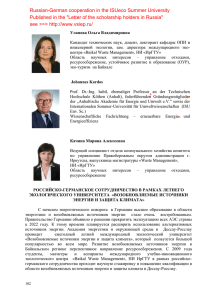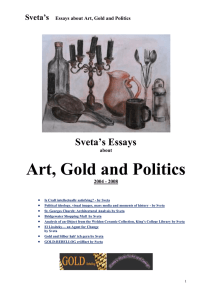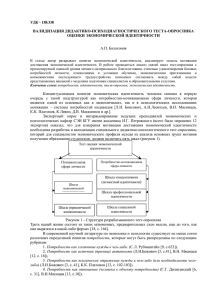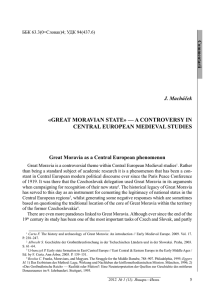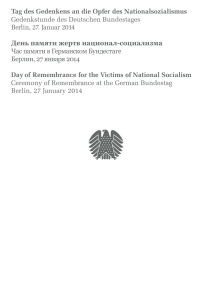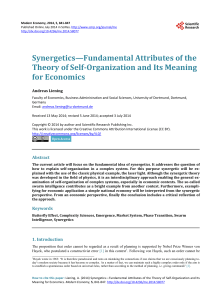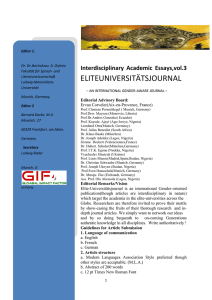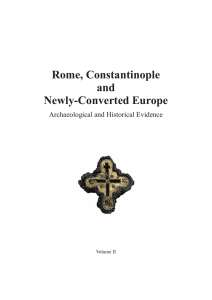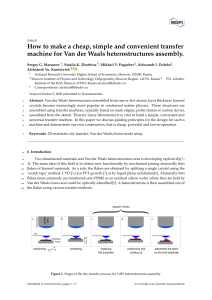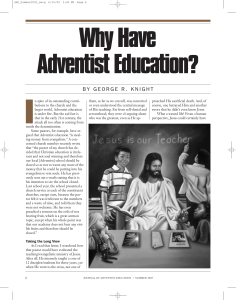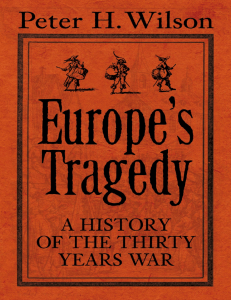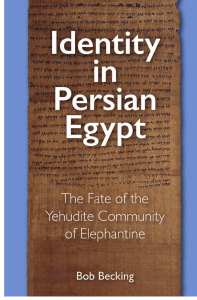Rome, Constantinople and Newly-Converted Europe
advertisement

Rome, Constantinople and Newly-Converted Europe Archaeological and Historical Evidence Volume I U ŹRÓDEŁ EUROPY ŚRODKOWO-WSCHODNIEJ / FRÜHZEIT OSTMITTELEUROPAS Geisteswissenschaftliches Zentrum Geschichte und Kultur Ostmitteleuropas, Leipzig Instytut Archeologii i Etnologii Polskiej Akademii Nauk, Warszawa Instytut Archeologii Uniwersytetu Rzeszowskiego, Rzeszów Rada Redakcyjna / Herausgebergremium Andrzej Buko, Christian Lübke, Małgorzata Rybicka Redakcja Serii / Redaktion der Reihe Matthias Hardt, Marcin Wołoszyn tom 1, część 1 / Band 1, Teil 1 Rome, Constantinople and Newly-Converted Europe Archaeological and Historical Evidence edited by Maciej Salamon, Marcin Wołoszyn, Alexander Musin, Perica Špehar in cooperation with Matthias Hardt, Mirosław P. Kruk, Aleksandra Sulikowska-Gąska Kraków – Leipzig – Rzeszów – Warszawa 2012 U ŹRÓDEŁ EUROPY ŚRODKOWO-WSCHODNIEJ / FRÜHZEIT OSTMITTELEUROPAS Geisteswissenschaftliches Zentrum Geschichte und Kultur Ostmitteleuropas e.V., Leipzig Instytut Archeologii i Etnologii Polskiej Akademii Nauk, Warszawa Instytut Archeologii Uniwersytetu Rzeszowskiego, Rzeszów Redakcja tomu / Redaktion des Bandes Maciej Salamon, Marcin Wołoszyn, Alexander Musin, Perica Špehar, Matthias Hardt, Mirosław P. Kruk, Aleksandra Sulikowska-Gąska Recenzenci tomu / Rezensenten des Bandes Eduard Mühle, Günther Prinzing Tłumaczenia / Übersetzungen Autorzy / Autoren, Alexey Gilevich, Monika Dzik oraz / sowie Anna Kinecka (j. angielski / Englisch), Katarzyna Łyp (j. niemiecki / Deutsch), Alexander Musin (j. rosyjski / Russisch) Weryfikacja językowa / Sprachverifizierung Marcin Bednarz, Anna Kinecka, Doris Wollenberg Skład / Layout Irena Jordan Obróbka graficzna / Graphik Autorzy / Autoren oraz / sowie Irena Jordan, przy udziale / unter Mitwirkung von Jolanta Ożóg, Rafał Janicki Projekt okładki / Layout des Umschlages Irena Jordan, Rafał Janicki Zdjęcie na okładce / Photo auf dem Umschlag Bizantyńska stauroteka (X / XI w.) z Ostrowa Lednickiego, zbiory Muzeum Pierwszych Piastów na Lednicy (Foto: R. Kujawa) Byzantinische Staurothek (10. / 11. Jh.) aus Ostrów Lednicki, Sammlungen des Muzeum Pierwszych Piastów na Lednicy (Photo: R. Kujawa) Druk tomu I / Druck von Band I Poligrafia Inspektoratu Towarzystwa Salezjańskiego, Kraków Dystrybucja / Distribution Leipziger Universitätsverlag Instytut Archeologii i Etnologii Polskiej Akademii Nauk Instytut Archeologii Uniwersytetu Rzeszowskiego © Copyright by Geisteswissenschaftliches Zentrum Geschichte und Kultur Ostmitteleuropas e.V., Leipzig 2012 © Copyright by Instytut Archeologii i Etnologii Polskiej Akademii Nauk, Warszawa 2012 © Copyright by Instytut Archeologii Uniwersytetu Rzeszowskiego, Rzeszów 2012 ISBN: 978-3-86583-659-5 ISBN: 978-83-89499-85-1 ISBN: 978-83-936467-0-8 The present volume is the result of cooperation of institutions named here: Polish Academy of Sciences Committee for the Research in Antique Culture Byzantine Commission = National Committee of the AIEB Institute of Archaeology and Ethnology Polish Academy of Sciences, Warsaw Leipzig Centre for History and Culture of East Central Europe (GWZO), Leipzig Institute of History Jagiellonian University, Cracow Institute of Archaeology University of Rzeszów, Rzeszów Institute for the History of Material Culture Russian Academy of Sciences, Saint Petersburg Institute of Archaeology Serbian Academy of Sciences and Arts, Belgrade Sponsored by: CONTENTS Editors’ Foreword ............................................................................................................................................................. 17 Jonathan Shepard Rome, Constantinople and Newly-Converted Europe: Archaeological and Historical Evidence. Some Introductory Remarks ............................................................................................................................................ 23 I.1 HISTORY: ROME, CONSTANTINOPLE AND THE NEW BORDERS THE INTRODUCTORY ESSAYS Jerzy Strzelczyk Missionsstrategie und Missionspraxis der westlichen Kirche im frühen Mittelalter ...................................................... 33 Maciej Salamon Byzantine Missionary Policy. Did It Exist? ..................................................................................................................... 43 Matthias Hardt Frühe Grenzen im Blick der europäischen Mediävistik .................................................................................................. 55 I.2 HISTORY: SEARCHING FOR ROME AND CONSTANTINOPLE FROM THE SOUTH TO THE NORTH Jenny Albani Painted decoration of the church of St. Onoufrius near Genna, Crete ............................................................................ 69 Georgios Th. Kardaras Christian symbols among the nomads, 5th-8th century A.D. ............................................................................................ 79 Georgi N. Nikolov Die Christianisierung der Bulgaren und das Mönchtum in der Familie des Khans Boris I. Michail im 9.-10. Jahrhundert ..................................................................................................................................................... 91 Angel Nikolov Making a new basileus: the case of Symeon of Bulgaria (893-927) reconsidered ........................................................ 101 Lumír Poláček Mikulčice und das Christentum in Mähren im 9. Jahrhundert ....................................................................................... 109 Béla Miklós Szőke Kulturelle Beziehungen zwischen Mosaburg/Zalavár und dem Mittelmeerraum .......................................................... 125 Márta Font Lateiner und Orthodoxe: Völker und ihre Gewohnheiten. Das Beispiel des mittelalterlichen Königreichs Ungarn .........143 Vincent Múcska Zur Frage der großmährisch-byzantinischen Tradition im früharpadischen Ungarn – Möglichkeiten der Interpretation ................................................................................................................................... 153 Petr Sommer Der Heilige Prokop, das Kloster Sázava und die sogenannte altkirchenslawische Liturgie in Böhmen ....................... 161 Jitka Komendová Rus’-Czech Relations during the Middle Ages as a Historiographical Problem ........................................................... 169 Christian Lübke Ottonen, Slaven und Byzanz .......................................................................................................................................... 175 Sabine Altmann Grenzüberschreitungen am westlichen Rand Ostmitteleuropas – Die Saale als Grenz- und Kontaktzone zwischen Frankenreich und slawischer Fürstenherrschaft im 9. Jahrhundert ...... 183 Stanisław Rosik Greeks and Romans in pagan Wolin. Integrating the Barbarians into the collective memory of the Latin West at the time of the conversion of the Slavs ......................................................................................... 195 Marian Dygo A Letter from Matthew, a Bishop of Cracow, to Bernard of Clairvaux “on the Conversion of Russians” (1145?) ..................................................................................................................... 203 Darius von Güttner-Sporzyński The archetypal crusader. Henry of Sandomierz, the second youngest son of Bolesław III ........................................... 215 Andrzej Buko Byzantine cultural enclave in Central Europe? An example of the mortared tower complex at Stołpie (south-eastern Poland) .................................................................................................................... 233 Alexey Chernetsov Paradoxical hierarchy of civilizations (Medieval Russian concept) .............................................................................. 251 Maja Gąssowska Der Heilige Olaf und Holmgård – Novgorod als Grenzraum zwischen Ost und West im 11.-12. Jahrhundert ............................................................................................................................. 263 Jukka Korpela Die Christianisierung der finno-ugrischen Peripherie Europas: Zwei Theorien und unangenehme Tatsachen ................................................................................................................. 275 Jörn Staecker Drei Magier auf einem gotländischen Bildstein. Die Perzeption des Epiphaniethemas in der Wikingerzeit ............................................................................................. 287 Anna Waśko Pagans in Erik’s Chronicle and in the Revelations of Saint Birgitta ............................................................................. 305 Volodymyr Bak Die Weihe Kyrillos II. (1242-1281) zum Metropoliten der Rus’ in den 40er-Jahren des 13. Jahrhunderts: ein Ereignis aus den kirchenpolitischen Beziehungen zwischen Halič-Volyn’ und dem Byzantinischen Reich ................................................................................................................ 311 Sebastian Kolditz Christliche Missionsbestrebungen und Konversionsansätze gegenüber den Steppenvölkern, insbesondere Pečenegen und Kumanen .............................................................................................. 319 II.1 ARCHAEOLOGY: ROME, CONSTANTINOPLE AND THE GRAVES THE INTRODUCTORY ESSAYS Sebastian Brather Pagan or Christian? Early medieval grave furnishings in Central Europe .................................................................... 333 Aleksandra Sulikowska-Gąska Funeral rites in Ruthenian iconography ......................................................................................................................... 351 Justyna Straczuk Death beliefs and practices among peasant inhabitants of the Catholic-Orthodox borderland in Belarus: an anthropological perspective .................................................................................................. 363 II.2 ARCHAEOLOGY: SEARCHING FOR ROME AND CONSTANTINOPLE FROM THE SOUTH TO THE NORTH Natalia Poulou-Papadimitriou, Elli Tzavella, Jeremy Ott Burial practices in Byzantine Greece: archaeological evidence and methodological problems for its interpretation ....................................................................................................... 377 Perica Špehar, Orhideja Zorova Christianity on the territory of the Archbishopric of Ohrid, 11th to the 13th century: archaeological evidence from burial sites ...................................................................................................................... 429 Lyudmila Doncheva-Petkova, Maria Christova La transition du paganisme au christianisme, reflétée dans les nécropoles du IXème-Xème siècle en Bulgarie ............... 447 Maja Petrinec Croatia between the East and the West – evidence from early medieval graves ........................................................... 461 Tina Milavec Sacred places? Eighth century graves near sixth century churches at Tonovcov grad (Slovenia) ................................ 475 Stefan Eichert Zu Christentum und Heidentum im slawischen Karantanien ........................................................................................ 489 Elisabeth Nowotny On the confessional situation between the Frankish Empire and Moravia in Carolingian times. Focus on archaeological sources from Lower Austria ................................................................................................... 503 Petr Hejhal, Michal Lutovský In agris sive in silvis… Secondary medieval burials in ancient barrows in Bohemia ................................................... 517 Anna Mazur, Krzysztof Mazur Des tombes à inhumation du Haut Moyen Age en Petite-Pologne: le cas de la nécropole de Wawrzeńczyce ....................................................................................................................... 525 Jacek Wrzesiński The Dziekanowice cemetery – Christians cultivating venerable traditions .................................................................. 535 Przemysław Urbańczyk A ‘Roman’ connection to the oldest burial in the Poznań Cathedral? ........................................................................... 553 Joanna Kalaga The early medieval hillfort at Sąsiadka in the light of 1930s-1950s research. Current status of post-excavation analysis of the archival record in the University of Warsaw .......................................................... 567 Jerzy Kuśnierz Das mittelalterliche Körpergräberfeld auf dem Burgwall von Gródek (altrussischer Volyn’) in Anbetracht der erhaltenen Grabungsdokumentation des Vorstandes zur Erforschung der Červenischen Burgen (1952-1955) ............ 579 Michał Dzik Bi-ritual burials in the central Bug river basin during the Middle Ages ....................................................................... 603 Łukasz Miechowicz Coins in the Western and Eastern Slavs burial practices in the Middle Ages – relicts of pagan beliefs or a sign of Christian traditions? .............................................................................................. 613 Vsevolod Ivakin Burial grounds and graves in medieval Kiev (10th to 13th century) ............................................................................... 625 Przemysław Sikora Die ostslawischen Bestattungssitten zu Beginn der Christianisierung am Rande der christlich-orthodoxen Welt am Beispiel Weißrusslands aus archäologischer Perspektive ............................................ 639 Anna Barvenova, Kristina Lavysh Burials in churches from the 11th-14th centuries on the territory of Belarus: influence of Christianization on the costume of the elite in the Western Rus’ principalities ........................................ 661 Eugenijus Svetikas Latin Christianisation in the Orthodox Christian Grand Duchy of Lithuania in late 14th and 15th centuries: a puzzle of historical facts and archaeological data ....................................................... 677 Roberts Spirģis Archaeological evidence on the spread of Christianity to the Lower Daugava area (10th-13th century) ........................ 689 Vitolds Muižnieks Archaeological evidence of 14th-18th century burial practices on the territory of Latvia .............................................. 713 Heiki Valk The Zhalnik Graves: Evidence of the Christianization of the Novgorod and Pskov Lands? ........................................ 737 Vladislav Sobolev On the process of formation of Early Rus’ burial culture in the Novgorod Land ......................................................... 751 Stanislav Bel’skiy, Ville Laakso New archaeological evidence on the Christianization in Karelia in the 13th-15th centuries (Northern Lake Ladoga region, Russian Federation) .................................................................................................... 767 СОДЕРЖАНИЕ Предисловие составителей .......................................................................................................................................... 17 Джонатан Шепард Рим, Константинополь и новая Европа: археологические и исторические свидетельства. Некоторые предварительные размышления ............................................................................................................... 23 I.1 ИСТОРИЯ: РИМ, КОНСТАНТИНОПОЛЬ, НОВЫЕ ГРАНИЦЫ ВВЕДЕНИЕ В ПРОБЛЕМУ Ежи Стржельчик Миссионерские стратегии и практики Латинской Церкви в раннем средневековье .............................................. 33 Мачей Саламон Существовала ли миссионерская политика в Византии? .......................................................................................... 43 Матиас Хардт Границы в исследованиях средневековой Европы ..................................................................................................... 55 I.2 ИСТОРИЯ: В ПОИСКАХ РИМА И КОНСТАНТИНОПОЛЯ С ЮГА НА СЕВЕР Ени Албани Настенные росписи XIV в. в церкви св.Онуфрия (Генна, остров Крит) ................................................................. 69 Георгиос Ф. Кардaрас Предметы с христианской символикой у кочевников в V-VIII вв. ........................................................................... 79 Георги Н. Николов Христианизация болгар и монашество в семье хана Бориса I – Михаила (IX-X вв.) ............................................ 91 Ангел Николов Становление нового василевса: новый взгляд на правление Симеона Болгарского (893-927) .............................. 101 Люмир Польачек Микульчицы и христианство в Моравии в IX в. ....................................................................................................... 109 Бела Миклош Сыке Культурные контакты между Блатенградом/Мозабругом/Залаваром и Средиземноморьем ................................ 125 Марта Фонт Латиняне и православные: люди и обычаи средневековой Венгрии ...................................................................... 143 Винсен Мучка К вопросу о моравской традиции в Венгрии эпохи первых Арпадовичей – возможности интерпретации ...................................................................................................................................... 153 Петр Соммер Святой Прокопий, Сазавский монастырь и «старославянское богослужение» в средневековой Чехии ............. 161 Йитка Комендова Русско-чешские отношения эпохи Средневековья как историографическая проблема ....................................... 169 Христиан Любке Оттониды, славяне и Византия .................................................................................................................................... 175 Сабинэ Альтман Пограничье на периферии Центральной и Восточной Европы: река Зале как граница и контактная зона между Франкской империей и славянскими княжествами ............................................................................. Станислав Рощик Греки и Римляне языческого Волина: варвары в коллективной памяти латинского Запада в эпоху христианизации славян ..................................................................................................................... Мариан Дыго Послание Матфея, епископа Краковского, к Бернарду Клервоскому «об обращении русских» (1145?) ............. Дариус фон Гютнер-Спожински Образцовый крестоносец? Генрих Сандомирский, младший сын Болеслава III .................................................. Анджей Буко Каменная башня в Столпье (Юго-Восточная Польша): византийский культурный анклав в Центральной Европе? ............................................................................................................................................... Алексей Чернецов Парадоксальная иерархия цивилизаций (древнерусский взгляд) ........................................................................... Майа Гонссовска Святой Олав и Хольмгард-Новгород как культурное пограничье между Востоком и Западом в XI-XII вв. ................................................................................................................................................. Юкка Корпела Христианизация Северо-Восточной Европы: две теории и неудобные факты ..................................................... Йорн Штекер Изображение трех волхвов на поминальном камне c Готланда: восприятие христианских сюжетов в языческом мире ......................................................................................................................................... Анна Ващко Язычники в Хронике Эрика и Откровениях св. Бригитты ...................................................................................... Владимир Бак Поставление Кирилла II (1242-1281) митрополитом вcея Руси в 1240-х гг. в контексте религиозно-политических связей Галицко-Волынской Руси и Византии .............................................................. Себастьян Колдиц Христианская миссия и христианизация степных народов в истории печенегов и половцев ............................. 183 195 203 215 233 251 263 275 287 305 311 319 II.1 АРХЕОЛОГИЯ: РИМ, КОНСТАНТИНОПОЛЬ, ПОГРЕБАЛЬНЫЙ ОБРЯД ВВЕДЕНИЕ В ПРОБЛЕМУ Себастьян Братер Язычники или христиане? Раннесредневековые погребения с инвентарем в Центральной Европе ................. 333 Александра Суликовска-Гонска Тема погребения в древнерусской иконографии ..................................................................................................... 351 Юстына Страчук Заупокойные верования и обряды сельского населения православно-католического пограничья Белоруссии в антропологической перспективе .................................................................................... 363 II.2 АРХЕОЛОГИЯ: В ПОИСКАХ РИМА И КОНСТАНТИНОПОЛЯ С ЮГА НА СЕВЕР Наталья Пулу-Пападимитриу, Елли Тсавелла, Джереми Отт Погребальный обряд византийской Греции: данные археологии и методологические проблемы их интерпретации ...................................................................................................................................... 377 Перица Шпехар, Орхидея Зорова Христианство на территории Охридской архиепископии в XI-XIII вв.: свидетельство археологии погребального обряда ............................................................................................................................. 429 Людмила Дончева-Петкова, Мария Христова Процесс перехода от язычества к христианству в Болгарии по материалaм раскопок некрополей IX-X вв. .................................................................................................................................................... 447 Майа Петринец Хорватия между Востоком и Западом по данным средневековых некрополей ...................................................... 461 Тина Милавец Священные места? Погребения VIII в. близь позднеантичной церкви Тоновцева града (Словения, VI в.) .......................................................................................................................................................... 475 Стефан Айхерт Христианство и язычество в Карантании .................................................................................................................. 489 Елизабет Новотны Конфессиональная ситуация на границе Франкской империи и Моравии в эпоху Каролингов по археологическим памятникам Нижней Австрии ................................................................................................. 503 Петр Хейхаль, Михал Лютовски In agris sive in silvis… Cредневековые впускные погребения в древних курганах Чехии .................................... 517 Анна Мазур, Кшиштов Мазур Раннесредневековые погребения в Малопольше – некрополь Вавженчице .......................................................... 525 Яцек Вжешиньски Некрополь в Декановичах – христианское развитие древних традиций ............................................................... 535 Пшемыслав Урбанчик «Римские» элементы древнейшего погребения кафедрального собора в Познани? ............................................ 553 Иоланта Кальага Средневековое городище в селе Сансядка: обзор археологических исследований 1930-1950-х гг. по материалам архивного собрания Варшавского университета ............................................................................ 567 Ежи Кушнеж Средневековые погребения городища Грудек (древнерусский Волынь) в свете архивных документов Научной Комиссии Польской Академии наук по изучению Червенских городов (1952-1955) ........................... 579 Михал Дзик Неполные трупосожжения в погребальном обряде центрального Побужья эпохи средневековья ................... 603 Лукаш Мехович Монеты в средневековом погребальном обряде западных и восточных славян: пережитки язычества или влияние христианства? ...................................................................................................................... 613 Всеволод Ивакин Погребальные памятники древнерусского Киева X-XIII вв. ................................................................................... 625 Пшемыслав Сикора Славянский погребальный обряд ранних этапов христианизации на окраинах восточно-христианского мира на примере Белоруссии – археологический подход ........................................................................................ 639 Анна Барвенова, Кристина Лавыш Погребения в храмах на территории Белоруссии XI-XIV вв.: роль христианизации в формировании костюма элиты княжеств Западной Руси ................................................................................................................... 661 Евгениус Светикас Латинская христианизация православных земель Великого княжества Литовского в конце XIV-XV вв.: исторические факты и данные археологии ............................................................................ 677 Робертс Спиргис Археологические свидетельства о распространении христианства в низовьях Западной Двины в X-XIII вв. ...................................................................................................................................... 689 Витольдс Музнекс Археология погребального обряда XIV-XVIII вв. на территории Латвии ............................................................. 713 Хейки Валк Жальники: свидетельство христианизации Новгородской и Псковской земли? ................................................... 737 Владислав Соболев Проблемы формирования древнерусской погребальной культуры Новгородской земли ..................................... 751 Станислав Бельский, Вилле Лааксо Новые археологические свидетельства о христианизации Приладожской Карелии в XIII-XV вв. ..................... 767 Rome, Constantinople and Newly-Converted Europe. Archaeological and Historical Evidence M. Salamon, M. Wołoszyn, A. Musin, P. Špehar, M. Hardt, M.P. Kruk, A. Sulikowska-Gąska (eds.) U ŹRÓDEŁ EUROPY ŚRODKOWO-WSCHODNIEJ/FRÜHZEIT OSTMITTELEUROPAS 1,1 Kraków-Leipzig-Rzeszów-Warszawa 2012, vol. I, p. 79-90 GEORGIOS Th. KARDARAS CHRISTIAN SYMBOLS AMONG THE NOMADS, 5TH-8TH CENTURY A.D. Abstract. Christian symbols among the nomads, 5th-8th century A.D. The paper investigates the presence of a variety of Christian symbols among the nomads during the Late Antiquity and the early Middle Ages, covering a quite broad geographical area, from the south Russian steppes to the Middle Danube. The nomadic peoples examined here are the Huns, the Avars, the early Bulgar tribes, and the early Khazars. Important parameters discussed are the contacts between these peoples and Byzantium as well as the efforts of the Byzantines to integrate the nomads into the Christian Oekoumene. Evidence from sources is provided for the plans to Christianise the nomadic peoples in the Caucasus area and the Black Sea (Savir Huns, Huns of Bosporus, Onogurs), an attempt linked to the economic and geopolitical interests of the Byzantines. Under consideration are also the archaeological finds (crosses, etc.) linked to the nomads of the aforementioned areas. A second – and possibly more complex – issue is the presence of Christian symbols within the Avar Khaganate, where there is no testimony for any missionary activity until the Charlemagne wars. In the area of the Middle Danube, a great number of Christian symbols have been found, such as decorative motifs on belts or rings, crosses of lead or silver, sarcophagi, the image of Christ or angels, themes from the Old Testament, etc. On these objects and motifs, many diverse assumptions have been proposed about their origin and character, such as the Christianization of a part of the Avars, the survival of small Christian communities or ecclesiastical centres from Late Antiquity, the role of others (Germanic or nomadic elements) in the diffusion of Christian motifs etc. The study considers the Christian symbols in the Avar Κhaganate as a result of imitation of byzantine stylistic motifs, making also reference to the tolerance the nomads showed towards Christianity. The target of Byzantine policy on a religious level was the gradual integration of all the nations into the Christian Oekoumene. Regarding the nomadic peoples, some early Christian authors, such as Johannes Chrysostom (Johannes Chrysostom, Psalm 44, p. 185) and Sozomenus (Sozomenus, VII. 26, p. 341), present the nomads (Scythians) in contact with Christianity in the 4th c. Orosius (Orosius, VII, 41.8, p. 122) counts the Huns among the Christianized nations, while Hieronymus (Hieronymus, ep. 107, p. 146) states that deposuit faretras Armenius, Hunni discunt psalterium, Scythiae frigora feruent calore fidei; Also, in the mid-6th century, Cosmas Indicopleustes (Cosmas, vol. I, 3.65, p. 504) includes in the Christian Oekoumene the Hepthalite Huns (see László 1940, 133; 1969, 143; Patoura-Spanou 2008, 76-80, 86, 138-144). The spread of Christianity to the nomads of the Black Sea and the Caucasus in the 4th and 5th centuries was mainly due to missionary activity (Kralides 2003, 188-190; Patoura-Spanou 2008, 142-144). On the other hand, from the beginning of the 6th century, we remark a combined effort of the Church and the state to 79 Georgios Th. Kardaras carry out the conversion of these areas. This more organized and intensive missionary activity was linked to the expansion and consolidation of the Byzantine influence in the Caucasus and the Black Sea (Papasotiriou 2000, 65-66, 105-108; Kralides 2003, 190-198; Patoura-Spanou 2008, 234-273). Regarding this political dimension in Byzantine historiography, A. Cameron points out that Procopius “[…] shows disapproval of military campaigns undertaken for motives of Christianization or for reinforcement of Christianity […]” and, in the case of the Iberians and the Lazi, “[…] never doubts that the religious affiliations of these peoples are a crucial factor in their situation as buffer between the two major states […]” (Cameron 1985, 122). Within the frame of the Byzantine-Persian controversy, Constantinople approached the rulers of the Crimean Huns and the Savirs. Presumably at the end of the reign of Justin I (518-527) a mission led by Kardutsat (Theokletos), bishop of the country of Arran, converted to Christianity many Savirs, together with their captives, and translated holy books into their language. When emperor Justin heard about this mission, he sent to the Savirs “[…] flour and wine and oil and linen cloths and other commodities and sacramental vessels […]” (Zachariah Rhetor, 12, p. 329-330; cf. also Kollautz 1970, 12-13; Kralides 2003, 192; Patoura-Spanou 2008, 257-260). In the case of the Hun leader Zilgivis (c. 520/22) and Boa, the queen of the Savirs (528), the Byzantines offered them gifts and money, but there is no mention of Christianization (Malalas, 10, p. 341-342 and 13, p. 360; Patoura-Spanou 2008, 257, 260-261). However, in 528, Grod, the rex of the Crimean Huns, came to Constantinople and was baptized. Grod tried to convert his people to Christianity and destroyed the pagan statues, but the reaction of the Hun priests led to the murder of Grod and the Byzantine guard of the city Bosporus (Malalas, 14, p. 360-362; Kollautz 1970, 13; Cameron 1985, 123; Kralides 2003, 192; Patoura-Spanou 2008, 261-263). There are also references to the Christianization of nomads in the 7th century: in 619, Orhan, the leader of the Onogur Bulgars and his nephew Kubrat visited Constantinople and were baptized (Johannes of Nikiu, 120. 47, p. 197; Nikephoros, 9, p. 48-50; Beševliev 1981, 149-153; Róna-Tas 2000). Furthermore, we are informed of the mission of Israel (Bishop of Caucasian Albania) in 681-682 to the Huns north of the Caucasus (Movses Dasxuranci, II. 39-42, p. 153-168; HowardJohnston 2007, 171; Zuckerman 2007, 408). Although the aforesaid efforts of the Byzantines did not result in a permanent conversion of some nomadic peoples, they brought them into contact with Christianity and spread among them the use of the relative Christian symbols. The latter were discovered in a number of graves in the Crimea and north of the Black Sea, as crosses, attributed to the 7th century, from Kelegeja (near Cherson), Skalistoje (along with amulets etc.), Chir-Jurt (between Volga and Don), Krylos, or the cross with Greek monogram [ΠΕΤΡΟΣ?] on a small statue from Voznesenskaya (see László 1940, 138; Bálint 1989, 94-95, 104; Veimarn, Aibabin 1993; Garam 2001, 61, 63; Aibabin 2006, 51). A diamond-shaped cross-piece decorates swords found at Malaya Pereshchepino, Voznesenskaya and Gladossy (Aibabin 2006, 54). Also, some nomadic graves in northern Fig. 1. Skalistoe, region Bakhchisaray, Autonomous Republic of Crimea, Ukraine. Crosses and capsulae; after E.W. Veimarn, A.I. Aibabin (1993, Fig. 121) redrawn by J. Ożóg. 80 Christian symbols among the nomads, 5th-8th century A.D. Caucasus, as in Gilach, Abrau-Dyurso, Pashkovskaya, Uzun-Kol and Kislovodsk contained capsulae, dated to the 5th or 6th century (Vida 1995, 224-230; cf. Fig. 1). The most important findings, linked to Kubrat, the ruler of Great Bulgaria, come from the grave at Malaya Pereshchepino. A silver disc, with a stamp of the Emperor Anastasius (491-518), bears a Christogram and the name of Paternus, Bishop of Tomis (498-520). The Christogram is surrounded by the inscription ex antiquis renovatum est per Paternum reverentiss(imum) episc(opum) nostrum amen. The disc is adorned also with 4 crosses, tendrils and grapes, skeps for the bread, a jug, deer, peacocks, etc., representations which possibly depicted the Heaven and the Eucharist. Another find was a plate with a depiction of a cross, and a bowl for hand-washing, presumably of a higher cleric, dated to the end of the 6th century (Werner 1984, 10-11; Bálint 1989, 98; Aibabin 2006, 53-54; cf. Fig. 2). Among the numerous archaeological remnants of the Avar Khaganate there are many objects with Christian symbols. Although there are no written references to the missionary activity to the Avars until the Frankish wars led by Charlemagne, the presence of these symbols gave rise to various assumptions, e.g., on missionary activity within the Avar Khaganate and conversion of a part of the Avars to Christianity (László 1940, 133; 1969, 146; Kollautz 1970, 24-27; Vida 1998, 536). In addition, some of the Christian symbols are linked either to the presence in the Carpathian Basin of Germanic peoples, e.g., Lombards and Gepids (László Fig. 2. Malaya Pereshchepino, region Novy Sanzhary, oblast’ Poltava Ukraine. Silver disc (no scale); after A. Bobrinskoy (1914, Fig. 1). 81 Georgios Th. Kardaras 1940, 131-132, 136; 1969, 143-144), or the survival of local, subjugated Christian communities, mainly around Keszthely and Pécs (László 1940, 128-130, 136; 1969, 144; Kollautz 1970, 19; Tóth 1987, 255-261). The Christian symbols in the Avar Khaganate appear on a wide spectrum of objects. The most characteristic examples are pectoral pendant crosses, either repousse or cast, possibly of Byzantine origin. The following sub-categories are worth mentioning: a) Crosses with an inscription: The most common inscriptions are the words ΖωΗ (zoe) = life, and ΦωC (fos) = light, as on the crosses from Balatonfűzfő (6th c.) and the one known from Grave No. 6 at Vajska (6th-7th c.). A well known example is the cross from Závod (Grave No. 104), dated to 6th-7th c. It is considered a Byzantine object and bears the inscription ΑΓΙΟC ΑΓΙΟC ΑΓΙΟC ΚC CΑΒΑΩ Τ (László 1940, 145; 1969, 150-151; Kollautz 1970, 22; Garam 2001, 57, 60-61). b) Gold, silver or bronze crosses, decorated with granulation, gemstones or imitation of the latter. Dated to the 6th-7th c., some imitations of Byzantine crosses are also preserved. Two of the best examples include the silver cross from Vajska (Grave No. 5), and the golden cross from Ozora-Tótipuszta (László 1940, 138; Garam 1991, 159-161; 2001, 57-63; Bugarski 2009, 221, 224-225). Fig. 3. Crosses and rings with Christian symbols from the territory of the Avar Khaganate; after T. Vida (1998, Fig. 2-3) redrawn by J. Ożóg. 1 – Székkutas, Komitat Csongrád, Hungary; 2 – Vajska, Južno-Bački Okrug, Serbia; 3 – Deszk, Komitat Csongrád, Hungary; 4-5 – Ozora-Totipuszta, Komitat Tolna, Hungary; 6 – Bóly, Komitat Baranya, Hungary; 7 – Vajska, Južno-Bački Okrug, Serbia; 8 – Budakalász, Komitat Peszt, Hungary; 9 – Bóly, Komitat Baranya, Hungary; 10 – Keszthely-Fenékpuszta, Komitat Zala, Hungary; 11 – Pilismarót, Komitat Komárom-Esztergom, Hungary; 12-13 – Pécs-Köztemetö, Komitat Baranya, Hungary; 14 – Várpalota-Gimnázium, Komitat Veszprém, Hungary. 82 Christian symbols among the nomads, 5th-8th century A.D. c) Lead pectoral crosses (9/10 undecorated), dated to the 6th and 7th c. They are recorded in a large territory, in northern and southern parts of Transdanubia, the southern Hungarian Plain, as well as the area between the Danube and the Tisza (Garam 2001, 59, 63-65; Bugarski 2009, 221-224, 229; cf. Fig. 3). Christian symbols were also used to ornament jewellery. Some half-moon shaped earrings, dated to the 6th-7th c., with depictions of crosses, monograms, pigeons or peacocks (symbols of immortality), etc., were discovered mainly in the area of Keszthely and Pécs. These earrings are considered either as imports from Byzantium or local imitations made according to Byzantine models. Crosses appear also on some earrings with star-shaped pendant (Garam 2001, 18-23). Among neck pendants are found small amulets (Reliquienkapseln, lead pendants etc.), decorated with Christian symbols. The small silver pendant from Balatonfűzfő with the inscription ΠΕΤΡΟC, is considered a Byzantine object. On the other hand, the lead pendants of the Avar period, which occur in poorly furnished female graves, are likely to be an imitation of small Byzantine golden pieces ornamented with crosses. Lead pendants were discovered in Transdanubia, between the Danube and the Tisza, as well as east of the Tisza (László 1969, 150; Kollautz, 1970, 30; Garam 2001, 34-37). Also regarded as an expression of Christian faith is a peculiar find of Byzantine provenance, the disc fibulae of the Keszthely-Pécs group with depictions of Christ, angels, holy riders, crosses etc. A continuity of this group is observed in Transdanubia up to the 8th c. (the so-called Baranya group). Possibly, the early finds from Keszthely-Fenékpuszta as well as the fibula with Greek inscription from Nagyharsány are related to Sirmium, which fell to the Avars in 582 (László 1969, 148-150; Kollautz 1970, 19-20, 24-27; Garam 1993, 103-105; Garam 2001, 51-57; Daim 2003, 476; cf. Fig. 4). The rich Christian finds from Keszthely, along with the presence there of a flourishing Christian community during the Early Avar Period have been interpreted in terms of survival of an ecclesiastical center linked with Rome (Daim 2003, 519). Regarding the ornament of silver or bronze rings in the Avar Khaganate, a special finger-ring type (Siegelringe) bears Greek monograms, crosses, or other Christian symbols, and originates from Byzantium. Simple or cross-shaped monograms are known from Keszthely-Fenékpuszta, Bóly, Zamárdi and PécsGyárváros. In some cases, the rings bear a variety of motifs, as crosses, birds and cypresses (Kölked). Another group of silver rings (Kopfplatte) are known from the cemetery around the Horreum at Keszthely-Fenékpuszta and are decorated with a cross, a fish or a couple (Graves No. 9, 16, 7). Seal-shaped rings were found mainly at Keszthely and Pécs, and also, in northwest Transdanubia (Budakalász, Környe). The cross-shaped pattern is seen too on some rings with spiral terminals (Garam 2001, 74-81). The cross-shaped ornament is a characteristic feature of Sucidava type buckles, their small number of finds dated to the Avar period are attributed mostly to Gepidic graves. The type is dated after the second third of the 6th c. and was widespread in the Balkans (Garam 2001, 95-97). As regards ornamentation of belts, we observe, next to crosses, mask fittings on the main straps. They are dated from the late 6th to the early 7th c., and are considered by É. Garam as depictions of Christ (Garam 2001, 130-132; Daim 2003, 476-477). The fish is the main motif on belts of Törökkanisza and Τarnaméra type. The belt mounts from Törökkanisza/Novi Kneževac are surounded by cypresses and dot-komma ornaments, while in the middle field the monogram ΑΡΕΘΟΥ is displayed. The Törökkanisza type belt fittings occur in the southern Hungarian Plain as well as between the Danube and the Tisza rivers. Medallions with Christian monograms are also to be found on the main strap-ends of belt sets of Kunágota -Mersin type (Bálint 1989, 156; Garam 2001, 77-78, 139-146; Daim 2003, 471). Ornaments used on belt fittings include depictions of birds (László 1969, 148; Garam 2001, 148-150) and motifs from the Old Testament, as Daniel, Jonah, etc. (Kollautz 1970, 32-37; Vida 1998, 534-535). Finally, we can distinguish Christian symbols (crosses or cross-shaped ornaments) on weights and assorted finds dating to the 7th c., as the silver plate from Tépe, a bowl from Zamárdi-Rétiföldek (Grave No. 244), and a lamp from Tápiógyörgye-Nagymegyerpuszta (Garam 2001, 160-162, 173-176; Daim 2003, 480, 482), which entered the Carpathian Basin either as a result of trade or as booty from Avar raids. Among the limited spectrum of finds featuring Christian symbols dated to the late 7th-8th centuries, we may include the crosses and the coffins from Székkutas (László 1969, 150-151; Vida 1998, 534; Daim 2003, 520), as well as crosses depicted on four vessels (No. 3, 4, 19 and 21) from the Nagyszentmiklós treasure (László 1940, 145; Bálint 2002, 60, 70, 79). 83 Georgios Th. Kardaras Fig. 4. Disc fibulae of the Keszthely-Pécs group (no scale); after E. Garam (2001, Pl. 32). 1 – Keszthely-Fenékpuszta, Horreum, Komitat Zala, Hungary, Grave No. 5; 2 – Nagyharsány, Komitat Baranya, Hungary; 3 – Keszthely-Dobogó, Komitat Zala, Hungary; 4 – Keszthely-Fenékpuszta, Horreum, Komitat Zala, Grave 14, Hungary; 5 – Keszthely-Dobogó, Komitat Zala, Hungary; 6-7 – Pécs-Gyárváros, Komitat Baranya, Hungary. The presence of the aforementioned symbols may be linked to the survival of Christian traditions within the Avar Khaganate, in the area of Pannonia Christianized before the Avar settlement (cf. Barton 1975). During the Avar era, despite the flight of Christian population, some Christian communities continued to survive, as at Κeszthely, at Savaria and the area of Sopianae/Pécs (Kollautz 1970, 19; Tóth 1987, 253-255; Garam 2001, 84 Christian symbols among the nomads, 5th-8th century A.D. 65). Moreover, we need to take into account that, apart from the gifts of Byzantine envoys and trade, the Avars came in contact with Christian symbols during their short stay north of the Black Sea and later brought these motifs to the Carpathian Basin. From the same area some other nomadic tribes moved with the Avars, e.g., the Kutrigurs and the Utigurs, who had already accepted the influence of Byzantine culture (László 1969, 143; Kralides 2003, 193). Independently of various assumptions regarding the presence of Christian symbols in the Avar Khaganate, the main problem consists in the attribution of these symbols to the Avars as an indication of the adoption of Christianity by them. As regards Byzantine-Avar relations, there is no evidence on missionary activity directed on the Avars. Consequently, the presence of Christian symbols and motifs on finds from the Avar Khaganate do not necessarily mean that a part of the Avars had adopted Christianity. Evidence from western sources on this topic is insufficient to support such an hypothesis. In 696, the Bishop Rupert of Salzburg avoided entering Pannonia (Vita Hrodberti..., 5, p. 159; Barton 1975, 204; Pohl 1988, 308) while the Bavarian Duke Theodo (between 685-690?) dissuaded Emmeram, Bishop of Regensburg, from undertaking missionary activity among the Avars (Arbeo Frisingensis, 5, p. 34; Barton 1975, 209; Tóth 1987, 263; Pohl 1988, 308; Wood 2001, 150151). Moreover, Carolingian sources on the Avars at the end of the 8th century, contain references on pagans and persecutors of Christians (Einhardus, p. 176 [a. 791] “[...] quam fecerunt Avari contra sanctam ecclesiam vel populum christianum, unde iustitias per missos impetrare non valuerunt [...]”; s. also László 1969, 146; Kollautz 1970, 15-16, 27; Tirr 1976, 111). The gradual conversion of the Avars started after their subjugation by Charlemagne in 796, who had the support of the Catholic clergy during his military operations (cf. Váczy 1972, 407-420; Pohl 1988, 204205, 320; Szöke 1990-1991, 145-149; Reimitz 2001, 190, 199-203). From Conventus Episcoporum of 796, we derive information on the survival of a Christian community and poor clergy in Pannonia: “Illi vero, qui ab inlitteratis clericis baptizati existunt et, cum intinguerentur in aqua, nec illi fidem, quia nesciebant, professi sunt, nec ille, qui baptizabat, dixit [...]” (Conventus Episcoporum..., p. 176 [a. 796]; cf. László 1969, 145; Barton 1975, 186; Tóth 1987, 262-263). The Christianization of the last Avars was completed some years later, when the Franks resettled them from their territory between the Danube and the Tisza to northwestern Pannonia (inter Sabariam et Carnuntum) in 805. On this occasion, some of the western authors mention Avar rulers with Christian names, such as Theodoros and Abraam (cf. László 1940, 145-146; Pohl 1988, 205, 302, 322; Szöke 1990-1991, 148). Basing on this evidence and despite the aforementioned finds, we could assume, as a general conclusion, that the Avars had not been converted to Christianity before the Frankish wars and had kept their own religion, e.g. shamanism. The Christian tradition and the relative symbols in the Avar Khaganate presumably are linked to the survival of small non-Avar communities, while for the Avars they were only decorative motifs without religious content (Kollautz 1955, 285-295; Pohl 1988, 200-204; Daim 2003, 520521; Bugarski 2009, 225-229). Christian communities had survived mostly at Keszthely and the area of Pécs, and apart from them we must consider the transfer of Christian population to the area of Sirmium after the Avar raids at the end of the 6th and the first decades of the 7th century. They were part of the so-called Sermisianoi, who moved in c. 680 to the Balkans under the leadership of Kuber (Beševliev 1981, 163-169; Pohl 1988, 278-279). Kuber is linked also to a Bulgarian migration in the 660’s from the south Russian steppes, which, according to some scholars, caused changes in the material culture in the Carpathian Basin (on the issue, see László 1940, 140; 1969, 150; Garam 1987, 196-197; Bálint 1989, 169-171, 174-175; see also Goldina 1992, 497-501)1. On the other hand, the coexistence of different populations within the Avar Khaganate could have influenced the lower classes of the Avars on a religious level, but even this assumption cannot be confirmed conclusively (see László 1940, 137, 140). As regards the spread of Christian symbols, most of them are found between the river Raab and the mouth of the Drava, and, second, in the region of Kiskörös and Szeged (László 1969, 152). There is much to suggest also, that the nomads rather than being persecutors of the Christians showed tolerance towards them. We can mention here e.g., the oath of Khagan Bayan made on the holy books in 579, declaring that he had no intention to attack Sirmium (Menander, fr. 25. 1, p. 221-223; Pohl 1988, 72). As an 1 We need to note that both the question of causes and of the chronology of material culture change on the territory of the Avar Khaganate during the second half of the 7th is still far from clear (cf. the results of the session Betrachtungen zur Chronologie der Mittelawarenzeit, Budapest, 26.-27.11.2004 published in Anteus, vol. 29-30 [2008], p. 29-401). 85 Georgios Th. Kardaras indication of tolerance to the influence of Christianity we may consider later, in the 8th century, the existence of Christian churches and bishoprics on nomad territory, such as Astil, Onogouron, Hunnon etc. (cf. Pletnjowa 1978, 42 [see also russian edition – 1976]; Kralides 2003, 198-200; Aibabin 2005, 423; Howard-Johnston 2007, 171-172). Резюме. Предметы с христианской символикой у кочевников в V-VIII вв. В статье анализируется феномен присутствия предметов с христианской символикой в культурах кочевых народов в эпоху поздней Античности и раннего средневековья на обширных пространствах от южно-русских степей до Среднего Подунавья. В исследование включены такие народы как гунны, авары, протоболгары и ранние хазары. К числу обсуждаемых тем относятся контакты кочевников с Византией, а также попытки византийцев христианизировать варваров. К числу обсуждаемыx проблем относятся контакты этих племен с Византией, также как и стремление Империи включить кочевников в христианскую Ойкумену. Источники свидетельствуют о христианизации народов на Северном Кавказе и в Причерноморье (савиры, боспорские гунны, оногуры) в связи с экономическими и геополитическими интересами Византии. В статье также рассматриваются археологические находки с христианской символикой, связанные с ханом Кубратом, христианскими правителями Великой Болгарии и ранними хазарами. С другим, более сложным комплексом проблем, соотносятся подобные находки на территории Аварского каганата, сведения о христианизации населения которого до эпохи войн Карла Великого отсутствуют. В Среднем Подунавье зафиксировано значительное число предметов с христианской символикой, в том числе орнаментированные поясные наборы и перстни, свинцовые и серебряные кресты, саркофаги, нecyщие на себе изображения Христа или ангелов, сюжеты Ветхого Завета и т.д. В отношении характера и происхождения этих предметов и орнаментальных мотивов предлагалось множество гипотез, среди которых обращение в христианство части авар, региональный континуитет небольших христианских общин или церковных центров, возникших еще в эпоху поздней Античности, проникновение христианских сюжетов на эти земли в результате межэтнических контактов с германскими племенами и другими номадами. Автор рассматривает христианскую символику на территории Аварского каганата как результат местного подражания византийским стилистическим мотивам в контексте терпимого отношения кочевников к христианству. 86 Christian symbols among the nomads, 5th-8th century A.D. Bibliography Abbreviations Monumenta Germaniae Historica. MGH Literary Sources Arbeonis episcopi Frisingensis, Vita vel passio Haimhrammi episcopi et martyris Ratisbonensis, B. Krusch (ed.), MGH. Scriptores rerum Germanicarum in usum scholarum, 13, Hannover 1920. Conventus Episcoporum... Conventus Episcoporum ad ripas Danubii a. 796, [in:] Concilia Aevi Karolini, A. Werminghoff (ed.), MGH. Legum sectio, 3, concilia, vol. II:1, Hannover-Leipzig 1906, p. 172-176. Cosmas Cosmas Indicopleustès, Topographie Chrétienne, W. Wolska-Conus (ed.), Paris 1968-1973, vol. I-III, Sources Chrétiennes 141, 159, 197. Einhardus Einhardi Annales, a. 741-829, G. Η. Pertz (ed.), MGH. Scriptores, 1, Hannover 1826, p. 135-218. Hieronymus Saint-Jérôme, Lettres, J. Labourt (ed.), Paris 1955, vol. V. Horosius Orose, Histoires (contre les païens), M.P. Arnaud-Lindet (ed.), Paris 1991, vol. III. Johannes Chrysostomus Johannes Chrysostomus, In Psalmum XLIV, J.P. Migne (ed.), Patrologia Graeca 55, Paris 1862. Johannes of Nikiu The Chronicle of John, Coptic Bishop of Nikiu, c. 690 A.D., R.H. Charles (ed.), London 1916. Malalas Ioannis Malalae, Chronographia, I. Thurn (ed.), Corpus Fontium Historiae Byzantinae, 35, Berlin-New York 2000. Menander The History of Menander the Guardsman, R.C. Blockley (ed.), ARCA Classical and Medieval Texts, Papers and Monographs, 17, Liverpool 1985. Movses Dasxuranci The History of the Caucasian Albanians by Movses Dasxuranci, C.J.F. Dowsett (ed.), London Oriental Series, 8, London 1961. Nikephoros Nikephoros, Patriarch of Constantinople: Short History, C. Mango (ed.), Dumbarton Oaks Texts, 10, Corpus Fontium Historiae Byzantinae, 13, Washington 1990. Sozomenus Sozomenus, Kirchengeschichte, J. Bidez, G.C. Hansen (ed.), Die Griechischen Christlichen Schriftsteller, 50, Berlin 1960. Vita Hrodberti... Vita Hrodberti episcopi Salisburgensis, [in:] B. Krusch, W. Levison (ed.), Passiones Vitaeque Sanctorum Aevi Merovingici et antiquiorum aliquot, MGH. Scriptores rerum Merovingicarum, 6, Hannover 1913, p. 140-162. Zachariah Rhetor The Syriac Chronicle known as that of Zachariah of Mytilene, F.J. Hamilton, E.W. Brooks (ed.), London 1899. Arbeo Frisingensis Studies Aibabin A. 2005 2006 On Byzantium’s northern border: The rural population of the mountainous Crimea in the 6th to 9th centuries, [in:] J. Lefort, C. Morrison, J.P. Sodini (eds.), Les villages dans l’empire byzantin (IVe-XVe siècle), Réalités Byzantines, 11, Paris, p. 415-424. Early Khazar archaeological monuments in Crimea and to the north of the Black Sea, [in:] C. Zuckerman (ed.), La Crimée entre Byzance et le Khaganat Khazar, Centre de recherche d’Histoire et Civilisation de Byzance, Monographies, 25, Paris, p. 31-65. 87 Georgios Th. Kardaras Bálint Cs. 1989 2002 Barton P.F. 1975 Die Archäologie der Steppe. Steppenvölker zwischen Wolga und Donau vom 6. bis zum 9. Jahrhundert, Wien-Κöln. A short essay on the Nagyszentmiklós treasure, [in:] T. Kovács, É. Garam (eds.), The Gold of the Avars. The Nagyszentmiklós Treasure. Magyar Nemzeti Múzeum, Budapest 24 March30 Juny, Budapest, p. 57-80. Die Frühzeit des Christentums in Österreich und Südostmitteleuropa bis 788, Studien und Texte zur Kirchengeschichte und Geschichte, 1, Wien-Köln-Graz. Beševliev V. 1981 Die protobulgarische Periode der bulgarischen Geschichte, Amsterdam. Bobrinskoy = Бобринской A.A. 1914 Перещепинский клад, [in:] Доклады, читанные на Лондонском международном конгрессе историков в марте 1913 г. графом А.А. Бобринским, Е.М. Придиком, М.И. Ростовцевым, Б.В. Фармаковским и Э.Р. фон Штерном, Материалы по археологии России, 34, Санкт-Петербург, р.111-120. Bugarski I. 2009 The meaning of the crosses in early Avar female graves: Three case studies from Vojvodina, Acta Archaeologica Carpathica, 44, p. 219-232. Cameron A. 1985 Procopius and the sixth century, Berkeley-Los Angeles. Daim F. 2003 Avars and Avar Archaeology. An Introduction, [in:] H.W. Goetz, J. Jarnut, W. Pohl (eds.), Regna et Gentes. The Relationship between Late Antique and Early Medieval Peoples and Kingdoms, The Transformation of the Roman World, 13, Leiden-Βoston, p. 463-569. Garam É. 1987 Der awarische Fundstoff im Karpatenbecken und seine zeitliche Gliederung, [in:] B. Hänsel (ed.), Die Völker Südosteuropas im 6. bis 8. Jahrhundert, Symposion Tutzing 1985, Südosteuropa Jahrbuch, 17, Wien, p. 191-202. 1991 Über Halsketten, Halsschmucke mit Anhängern und Juvelenkragen byzantinischen Ursprungs aus der Awarenzeit, Acta Archaeologica Academiae Scientiarum Hungaricae, 43/1-2, p. 151-179. 1993 Die awarenzeitliche Scheibenfibeln, Communicationes Archaeologicae Hungariae, p. 99134. 2001 Funde byzantinischer Herkunft in der Awarenzeit vom Ende des 6. bis zum Ende des 7. Jahrhunderts, Monumenta Avarorum Archaeologica, 5, Βudapest. Goldina E. 1992 Gürtelteile mit Pflanzenornamenten aus dem Kamagebiet, [in:] F. Daim (ed.), Awarenforschungen, vol. 1, Archaeologia Austriaca Monographien 1, Studien zur Archäologie der Awaren, 4, Wien, p. 497-508. Howard-Johnston J. 2007 Byzantine Sources for Khazar History, [in:] P.B. Golden, H. Ben-Shammai, A. Róna (eds.), The World of the Khazars. New Perspectives. Selected Papers from the Jerusalem 1999 International Khazar Colloquium hosted by the Ben Zvi Institute, Handbook of Oriental Studies, 17, Leiden-Boston, p. 163-193. Kollautz Α. 1955 Der Schamanismus der Awaren. Beiträge zur Religion der Awaren (1), Palaeologia, 4/3-4, p. 285-295. 1970 Denkmäler Byzantinischen Christentums aus der Awarenzeit der Donauländer, Zetemata Byzantina, 2, Amsterdam. 88 Christian symbols among the nomads, 5th-8th century A.D. Kralides = Κραλίδης A. 2003 Οι Χάζαροι και το Βυζάντιο. Ιστορική και θρησκειολογική προσέγγιση, Αθήνα. László G. 1940 Die Reiternomaden der Völkerwanderungszeit und das Christentum in Ungarn, Zeitschrift für Kirchengeschichte, 59, p. 125-146. 1969 Die Awaren und das Christentum im Donauraum und im östlichen Mitteleuropa, [in:] F. Zagiba (eds.), Das heidnische und christliche Slaventum. Acta II Congressus internationalis historiae Slavicae Salisburgo-Ratisbonensis anno 1967 celebrati, Annales Instituti Slavici, 5, Wiesbaden, p. 141-152. Papasotiriou = Παπασωτηρίου Χ. 2000 Βυζαντινή υψηλή στρατηγική, 6ος-11ος αιώνας, Αθήνα. Patoura-Spanou = Πατούρα-Σπανού Σ. 2008 Χριστιανισµός και παγκοσµιότητα στο πρώιµο Βυζάντιο. Από τη θεωρία στην πράξη, Εθνικό Ίδρυµα Ερευνών/Ινστιτούτο Βυζαντινών Ερευνών, Μονογραφίες, 10, Αθήνα. Pletnjowa = Плетнева С.А. 1976 Хазары, Москва. 1978 Die Chasaren. Mittelalterliches Reich an Don und Wolga, Leipzig. Pohl W. 1988 Die Awaren. Ein Steppenvolk in Mitteleuropa, 567-822 n. Chr., Μünchen. Reimitz H. 2001 Conversion and Control: The Establishment of Liturgical Frontiers in Carolingian Pannonia, [in:] W. Pohl, I. Wood, H. Reimitz (eds.), The Transformation of Frontiers. From Late Antiquity to the Carolingians, The Transformation of the Roman World, 10, Leiden-Βoston, p. 189-207. Róna-Tas A. 2000 Where was Khuvrat’s Bulgharia? Acta Orientalia Hungarica, 53/1-2, p. 1-22. Szöke B.M. 1990-1991 The Question of Continuity in the Carpathian Basin of the 9th Century A.D., Antaeus, 1920, p. 145-157. Tirr D.A. 1976 The Attitude of the West towards the Avars, Acta Archaeologica Academiae Scientiarum Hungaricae, 28, p. 111-121. Tóth E. 1987 Bemerkungen zur Kontinuität der römischen Provinzialbevölkerung in Transdanubien (Nordpannonien), [in:] B. Hänsel (ed.), Die Völker Südosteuropas im 6. bis 8. Jahrhundert, Symposion Tutzing 1985, Südosteuropa Jahrbuch, 17, Wien, p. 251-264. Váczy P. 1972 Der fränkische Krieg und das Volk der Awaren, Acta Antiqua Hungarica, 20, p. 395-420. Veimarn, Aibabin = Веймарн Е.В., Айбабин А.И. 1993 Скалисmинский могильник, Киев. Vida T. 1995 Frühmittelalterliche scheiben- und kugelförmige Amulettkapseln zwischen Kaukasus, Kastilien und Picardie, Bericht der Römisch-Germanischen Komission, 76, p. 219-290. 1998 Neue Beiträge zur Forschung der frühchristlichen Funde der Awarenzeit, [in:] N. Cambi, E. Marin (eds.), Acta XIII Congressus Internationalis Archaeologiae Christianae. SplitPoreč 1994, Vjesnik za Archeologiju i Historiju Dalmatinsku, Supl., 87-89, Split, p. 529-540. Werner J. 1984 Der Grabfund von Malaja Pereščepina und Kuvrat, Kagan der Bulgaren, Bayerische Akademie der Wissenschaften, Philosophisch-Historische Klasse, Abhandlungen, N.F., 91, München. 89 Georgios Th. Kardaras Wood I. 2001 Zuckerman C. 2007 The Missionary Life. Saints and the Evangelisation of Europe, 400-1050, London. The Khazars and Byzantium-the first Encounter, [in:] P.B. Golden, H. Ben-Shammai, A. Róna (eds.), The World of the Khazars. New Perspectives. Selected Papers from the Jerusalem 1999 International Khazar Colloquium hosted by the Ben Zvi Institute, Handbook of Oriental Studies, 17, Leiden-Boston, p. 399-432. Address of the Author: Δρ. Γεώργιος Θ. Καρδαράς Εθνικό Ίδρυµα Ερευνών (ΕΙΕ) Ινστιτούτο Βυζαντινών Ερευνών (ΙΒΕ) Βασιλέως Κωνσταντίνου 48 11635 – Αθήνα ΕΛΛΑΔΑ email: georgekar3@yahoo.com 90 Dr Georgios Th. Kardaras National Hellenic Research Foundation Institute for Byzantine Research Vassileos Constantinou 48 11635 – Athens GREECE email: georgekar3@yahoo.com
